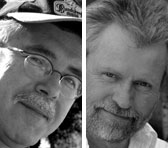29 October 2008
Synergy and Grainger Quartet
Sydney // NSW // 17.10.2008
 Image: Gerard Brophy and Ross Edwards
Image: Gerard Brophy and Ross Edwards Review by L. Mathison
The Grainger Quartet branched out of their comfort zone in this inspired concert with Synergy Percussion and William Barton. The program read like a who's who of Australian music: William Barton, Gerard Brophy, Peter Sculthorpe, Percy Grainger and Ross Edwards.
Three works by Percy Grainger opened the evening; Random Round, Beautiful Fresh Flower and Arrival Platform Humlet, arranged for string quartet and percussion by the two ensembles, with Peter Sculthorpe and James Cuddeford. These tuneful and relatively simple arrangements were quirky and evocative - I couldn't help but think that the eccentric Grainger would most certainly have approved.
The Australian premiere of Brophy's Vox Angelica, by Synergy Percussion and Grainger Quartet, was a highlight. After the composer's amusing introduction, subdued percussion and lyrical, high violins began the multi-layered landscape of sound. A rather meditative work, the gossamer textures were enriched by chiming percussion, undulating chordal sonorities and sections of fleeting liveliness.
There were some disappointed groans from the audience when it was revealed that William Barton's new work, Petricore, would not see its premiere due to his illness. However, all were happily consoled by his performance of Digi Fusion for didjeridu and guitar, a virtuosic piece pulsating with energy and rapid-fire guitar fingerwork. The didjeridu provided a heartbeat to the piece and also contributed a great variety of intriguing sounds. It was easy to see why Barton has been making an increasing name for himself both nationally and overseas, and the performance was very well received by the audience.
Grainger Quartet gave an impressive and evocative performance of Sculthorpe's melodious String Quartet No. 12, which has become the composer's and Barton's signature piece. Derived from Sculthorpe's 1986 orchestral work, Earth Cry, the four-part work fluctuated between the ritualistic, rustic and the lyrical. The didjeridu, here pitched on C, represented the earth, and its deep, consistent rumbling gave another dimension to the conventional string quartet and evoked the spaciousness so characteristic of the Australian landscape.
Two more works by Schulthorpe, the gentle Djilile and passionate Jabiru Dreaming, were also inspired by Australia - an Aboriginal chant and a rock formation in Kakadu respectively - and saw vibrant performances, including solos by violist Jeremy Williams and lead violinist Natsuko Yoshimoto, with an unassuming and moving vocal performance by Barton.
It might have looked a little out of place in a concert of predominantly Australian music, but Stockhausen's Tierkreis (Zodiac), commemorating the 80th anniversary of the composer's birth, fitted perfectly into the program. James Cudderford, who knew the late composer, introduced the work, and his arrangement of this oft-performed piece effectively explored the musical possibilities of the combination of Synergy and the Grainger Quartet. Moving seamlessly between illusory and teasing, brooding and intense, the work explored all the instrumental groupings.
The hall faded into darkness for the second Australian premiere of the evening - Ross Edwards's Tucson Mantras - which concluded the concert in a fusion of styles and instruments. With only flickers of light emitting from the performers' stands, this ruminative and evocative work was something of a meditation upon the sounds of the earth, conveyed through Edwards's use of bird, insect and frog sounds. Like Sculthorpe's string quartet, Tucson Mantras incorporated a didjeridu drone to represent the earth. The overall mood was one of reverence, although the piece gradually built towards a joyful and expansive conclusion.
Such musical collaboration should be further encouraged; in this concert, performers from different cultural and musical backgrounds opened doors to creativity, and performances were of an exceptional standard.
Performance details
Mantras and Angels
Synergy Percussion, Grainger Quartet, William Barton
Music by Barton, Brophy, Edwards, Grainger and Sculthorpe
City Recital Hall, Angel Place, Sydney, NSW
17 October 2008
Further links
William Barton (www.williambarton.com.au/)
Gerard Brophy (www.amcoz.com.au/composers/composer.asp?id=1950)
Ross Edwards (www.amcoz.com.au/composers/composer.asp?id=436)
Percy Grainger (www.amcoz.com.au/composers/composer.asp?id=243)
Peter Sculthorpe (www.amcoz.com.au/composers/composer.asp?id=241)
Grainger Quartet (www.graingerquartet.com)
Synergy Percussion (www.synergypercussion.com)
© Australian Music Centre (2008) — Permission must be obtained from the AMC if you wish to reproduce this article either online or in print.
Comments
Be the first to share add your thoughts and opinions in response to this article.
You must login to post a comment.